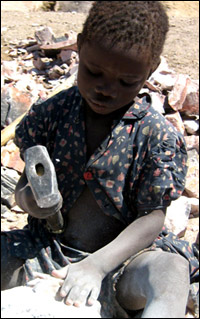READ
In Starving Southern Africa, Women Risk AIDS For Food

|
|
 |
Maria
Banda, just five years old, and her grandmother, Aineli, spend every day breaking stones into gravel in quarries a few kilometres from the heart of Zambia's capital, Lusaka. Hundreds of others are doing the same.
Maria produces two to three tins each day, her grandmother as many as nine, which they sell for 50¢ a tin. Roadside stalls sell the chipped stones to construction companies, but the demand is oversupplied. This backbreaking work pays for their $15 monthly rent; the rest provides a meagre living.
"We eat nshima [cornmeal] once, before going to bed, because I don't have enough money to buy food to eat twice. If something remains after we have eaten, then Maria has to finish it in the morning before we go for work, otherwise I will have to buy her some fritters around 12:00 if she didn't eat anything in the morning," Aineli, aged about 70, told IRIN.
|
|
|
Small but agile, Maria's left hand sweeps away the gravel from the stone she has just crushed and swiftly puts another one against a larger pebble. Her right hand brings down a big hammer to pound it. "I was hurting myself when I started doing this work but now I know how to avoid the hammer," she says.
 | |
Five year-old Maria works in a quarry on the outskirts of the Zambian capital(PHOTO: © Nebert Mulenga/IRIN)
|
Maria has been living with her grandmother since her parents died from a suspected AIDS-related illness a year ago. Barefoot and dusty, her struggle to survive is a snapshot of the growing number of children drawn into the labor market here.
More than 600,000 children in Zambia are believed to be working on farms, in construction and other business sectors, and in the sex industry.
Anne Kamwendo, project officer for the protection of children at the United Nations International Children's Fund (UNICEF), said children were forced to work to supplement low household incomes.
"Poverty and HIV/AIDS are the major causes of child labor, after creating an army of orphans and vulnerable children who are now being left in the care of aged grandparents or extended family members. When times are hard, these guardians tell the children to begin contributing to their own welfare by doing some form of work for money."
Although Zambia is signatory to the conventions of the International Labor Organization (ILO), and although its laws do not allow children below the age of 15 to work for a living, for many of the country's million or more HIV/AIDS orphans and vulnerable children, there is little alternative.
Grade six pupil Mervis Mulenga, 11, is one of nine children. She works in the stone quarry because her mother told her they needed to pay for schooling and clothing.
"I am forcing myself to crush at least five tins in one day because I really want to become a nurse when I finish school. I start crushing my stones around seven [in the morning] after cleaning the house, and I go to school at eleven," she said. When school finishes, she either goes back to the quarries or helps her mother at home.
By early evening, with only candles for light, sleep takes often precedence over homework.
A hacking cough is often the telltale sign of a child working long days in the dust-laden air of the quarry said Godfridah Sumaili, president of the Jesus Cares Ministry. "When they first come to our centers, most of the children from stone crushing have physical symptoms of their neglect, such as stunted growth and bodily injuries. They look harassed, afflicted, hopeless and lifeless," said Sumaili.
"They appear withdrawn and reserved. They have not known to look at themselves as children, but as adults, and some of them actually head families. Therefore, parents and guardians also refuse to let go of such children, who are perceived as economic pillars."
With assistance from the ILO and UNICEF, the ministry has managed to withdraw 5,000 children from various types of labor, including 3,000 previously involved in stone crushing. Some have been reintegrated into the formal primary school system, while others are attending the organization's community schools throughout the country.
© IRIN
[Integrated Regional Information Networks is a project the UN Office for the Coordination of Humanitarian Affairs. This article does not necessarily reflect the views of the United Nations or its agencies.]
Comments? Send a letter to the editor.Albion Monitor September
5, 2006 (http://www.albionmonitor.com)All Rights Reserved. Contact rights@monitor.net for permission to use in any format. |
|








